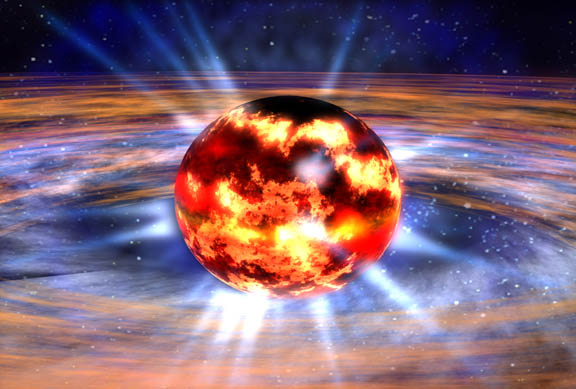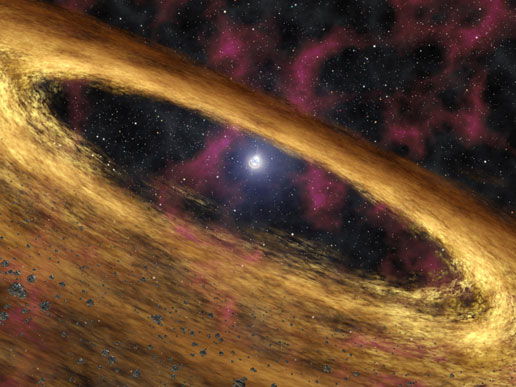Table of Contents
Neutron Stars
Neutron stars are the most dense objects currently known in the universe, having densities up to several times those of nuclei. Also, neutron stars are also made of mostly nucleons bound together by gravity. Due to this similarity in density and composition it is plausible to extend the equation of state which governs nuclei to these exotic stellar objects. This cannot be applied without caution however, because there are certainly differences between nuclei and neutron stars.
How are they formed?
The way stars end their lives is highly dependent upon the amount of mass that they contain. Average mass stars such as our sun lack the gravitational energy to produce dense matter objects such as neutron stars or black holes and will simply shed their envelopes becoming white dwarfs. They may however gain sufficient mass through a binary partner to push them over the chandrasekhar limit at which point electron degeneracy pressure will not be sufficient to stave off gravitational collapse to a neutron star.
White Dwarf
Stars more massive than our sun will explode and compress their cores into extremely dense objects that will either become neutron stars or black holes. There is a limit to the mass that neutron stars can contain. This boundary is near 3 solar masses, at which point the neutron degeracy pressure is not sufficient to stave off the pull of gravity and the star will collapse under its own gravity into a black hole. The limit for a star to form a neutron star and not a black hole is entirely dependent on the amount of matter that is expelled from the core into the interstellar medium. This means that a relativly small 4-8 M star may create a neutron star if little of the outer gases are lost in the explosion, while a large mass star 25-40 M star may also form a neutron star of most of the material is lost from the star.
Properties of neutron stars
Neutron stars are very dense bodies created from the collapse of stars. Due to this great density they are much smaller then their diffuse progenitors. While a star may have a diameter of a million kilometers the diameter of a neutron star is much smaller, on average only 10 or so kilometers across. This great density increase creates very unique properties such as extremely high gravitational and magnetic forces. Also, because momentum must be conserved neutron stars spin at a phenomenal rate measured as a few seconds in the slowest cases, and down to milliseconds in rare cases.
The rapid rotation of these neutron stars can produce emissions which seem to pulse when viewed from earth. These emissions can occur at virtually any wavelength in the spectrum, and are characterized by being at equally spaced intervals. Neutron stars which produce these events are called pulsars. Also there are neutron stars with exceptionally high magnetic fields that are the strongest known magnets in the universe. While their formation remains a mystery they are never the less thought to be the strongest magnets in the known universe.
Differences between nuclei and neutron stars
While there are similar properties between nuclei and neutron stars there are also key differences. The first major difference is that nuclei are held together by the strong force and neutron stars are held together by gravity.
Secondly, most stable nuclei have roughly the same number of protons and neutrons. This is not the case in neutron stars because of the incredible densities present. This density allows for relatively stable nuclei to occupy the surface of the neutron star, but as you travel inwards neutrons tend to dominate.
Equation of state
Even though there are differences between the neutron stars and nuclei there are enough similarities to try and extend the equation of state to include them. If successful this would allow a greater understanding of these presently mysterious objects. Also, the very neutron rich stellar material could aid in understanding how very heavy neutron rich nuclei behave.


